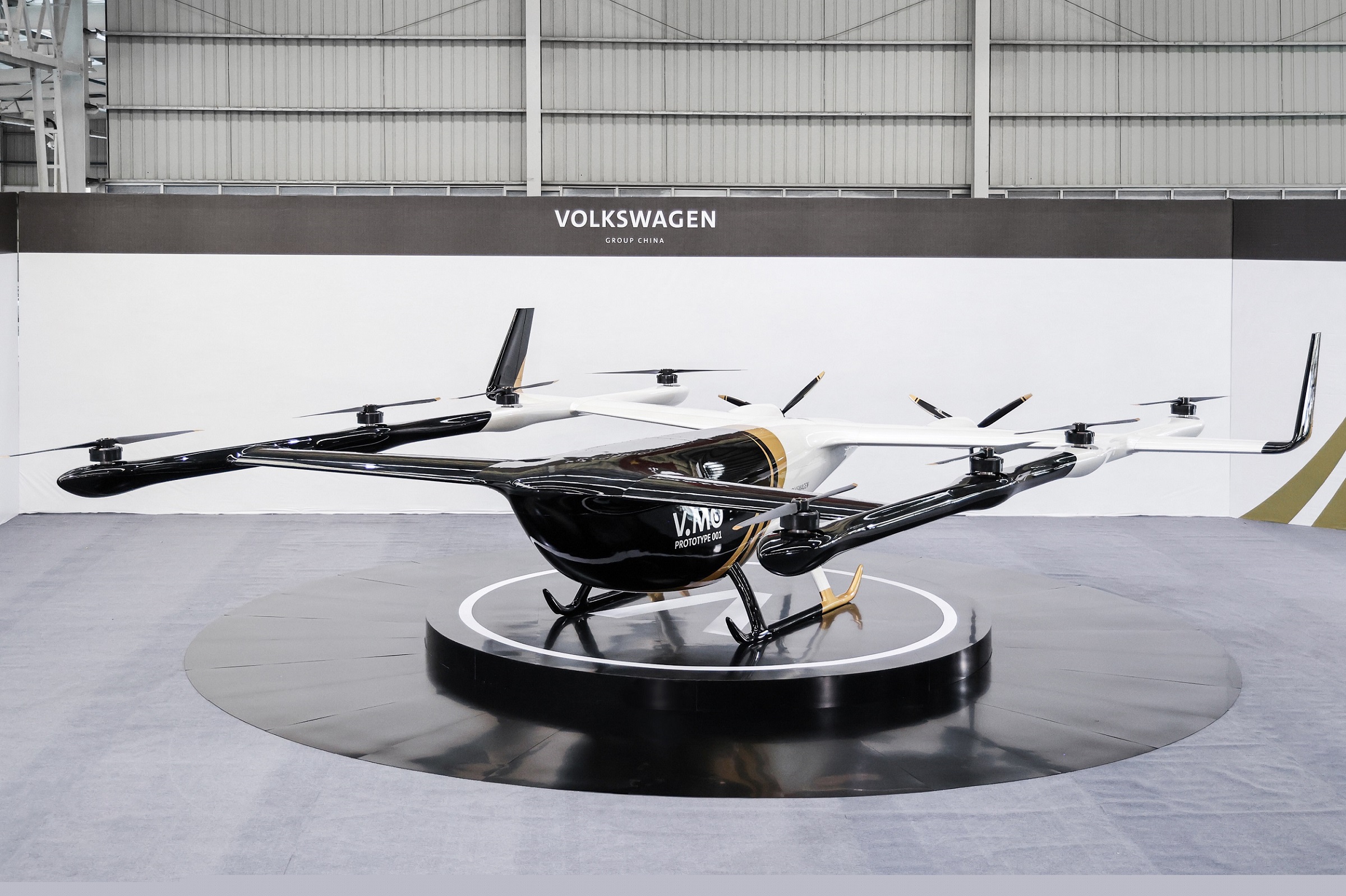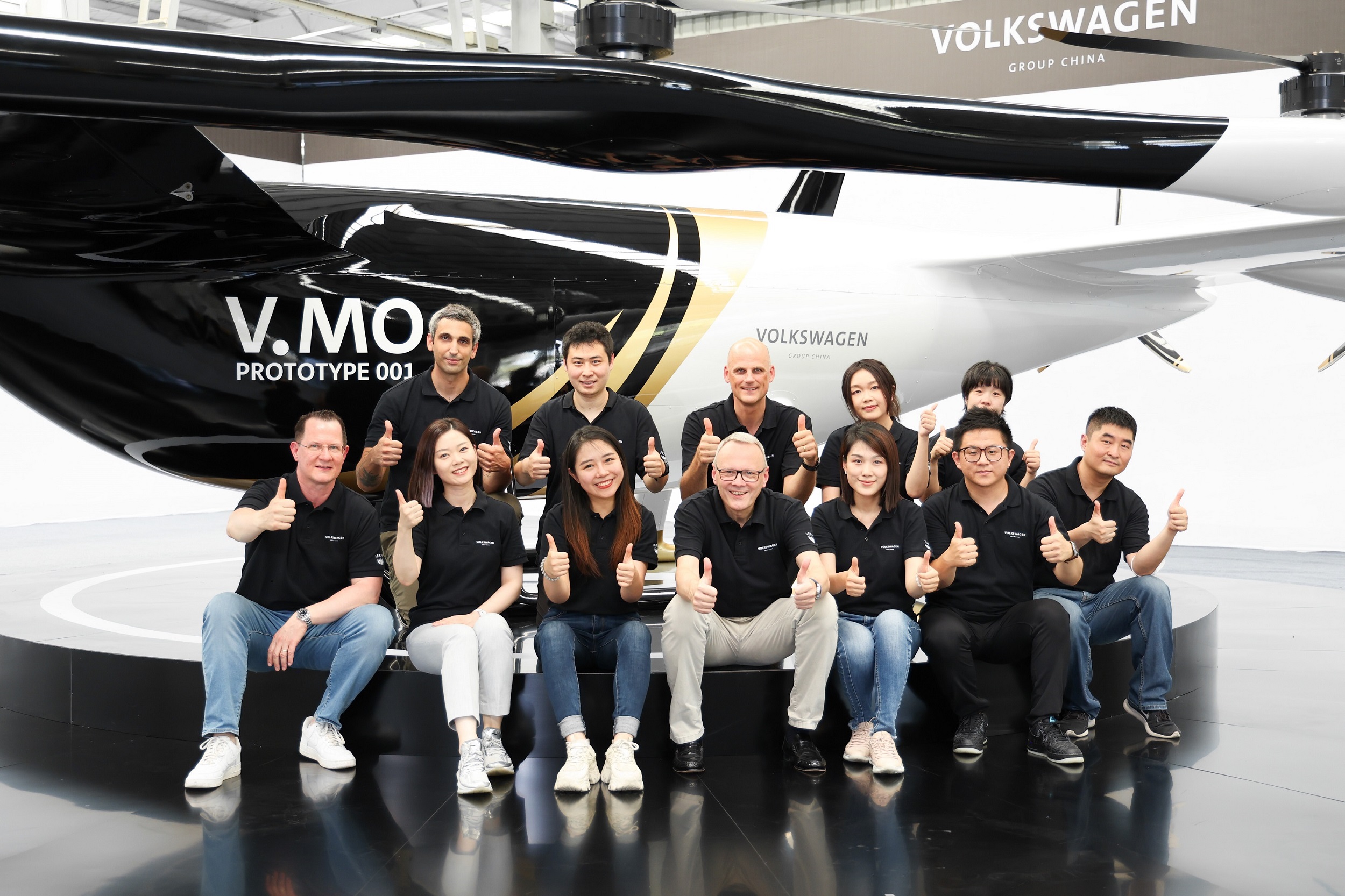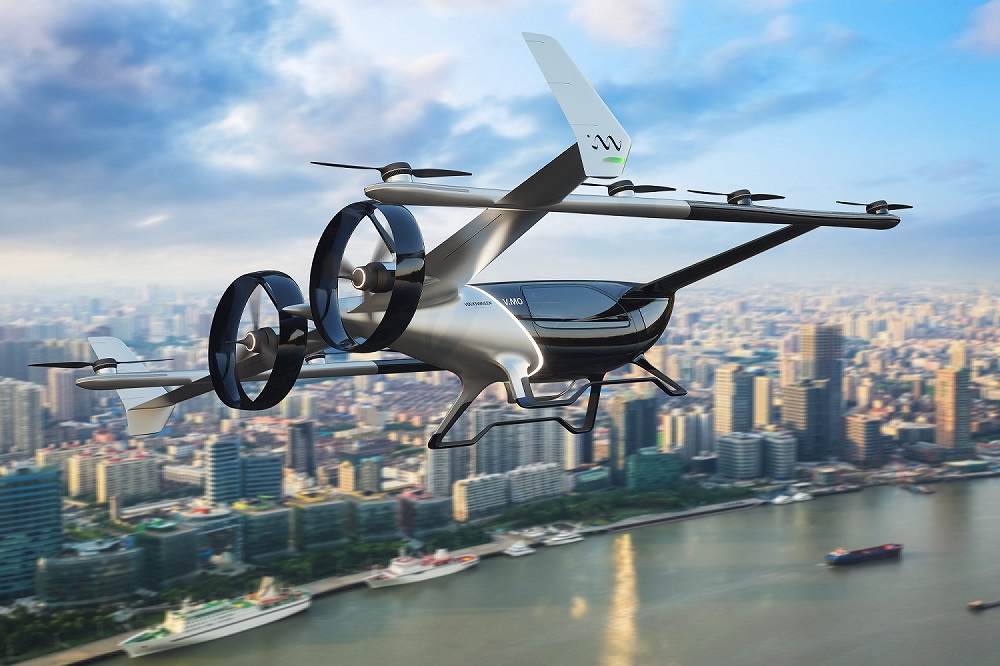The company’s China division has unveiled it has been working on a passenger-carrying e-VTOL – and says it plans to commercialise it down the road. The prototype is called V.MO and is part of Volkswagen China’s Vertical Mobility project.
“Through this pilot project, we are bringing Volkswagen’s long tradition of precision engineering, design, and innovation to the next level, by developing a premium product that will serve the vertical mobility needs of our future tech savvy Chinese customers,” said Dr. Stephan Wöllenstein, CEO of Volkswagen Group China.
“This is a pioneering project which our young team of Chinese experts started from scratch – they are working with new design concepts and materials while developing new safety standards, disrupting and innovating every step of the way. Our long-term aim is to industrialize this concept and, like a ‘Flying Tiger’, break new ground in this emerging and fast-evolving new mobility market.”
The ‘Flying Tiger’ nickname refers to the prototype’s gold and black livery – which you’ll see in the photo below. We’ve added a second image with people for scale.


“In its final future iteration, the fully electric and automated eVTOL could eventually carry four passengers plus luggage over a distance of up to 200km,” states a Volkswagen news release on the project.
This first prototype appears to be built for unmanned testing and validation. The company says several test flights of V.MO will take place later this year, with plans for an improved prototype to be flying in the summer of 2023.
And what might it look like? Well, probably something like this animation:
The press release announcing the prototype made it clear that Volkswagen sees vast potential in Urban Air Mobility and products like these.
“Urban air mobility is a fast-emerging market which aims to utilize air space for short- and medium-distance connections, especially above and between large cities,” it states. “In China, it is set to play a significant role in the future of urban and intercity transportation in its congested megacities. In the first phase of its commercial use, V.MO is likely to be pitched as a premium product for high-net worth tech savvy Chinese customers, for example for VIP air shuttle services. eVTOL air vehicles will be able to transport passengers more quickly and efficiently than current conventional means of terrestrial transport and with greater flexibility. As the Vertical Mobility project develops, Volkswagen Group China will work with the relevant Chinese authorities to achieve certification.”
With the announcement, Volkswagen becomes the latest automotive player to stake a claim in this sector. Honda, Toyota, Aston Martin and others have announced they’re entering the space and have displayed concepts, prototypes or renders of their plans. Hyundai unveiled this Uber Air taxi concept a couple of years back:
Still some hurdles
Will we be seeing these vehicles – in real life – in the years to come?
The answer is yes, but there are still challenges that must be overcome. Urban Air Mobility envisions a future where eVTOLs will transit congested urban centres, whisking passengers who will likely summon these aircraft using mobile apps to nearby take-off and landing sites. UAM will also bring the option of convenient flight traffic between nearby cities where one or both do not have the infrastructure or demand to support traditional fixed-wing aircraft. Plus, the ability to deliver people or goods to central locations in a large city offers a convenience that eludes most traditional airports.
But getting there will take some time. These eVTOLs will face rigid certification, and require a robust Unmanned Traffic Management (UTM) system/network to ensure there’s no conflict with drones or other forms of aviation. Work on those fronts is underway. In fact, the White House even held a special summit on the topic August 3. The goal of that gathering was to explore “the future of aviation in America and the regulatory strategy towards responsible and equitable adoption of these technologies.”
It’s clearly firmly on the radar of regulators.
Multiple designs, including single-person eVTOLs
There are many different companies vying for a piece of this territory. Perhaps the one with the greatest advantage is China’s eHang, which produces one- and two-passenger autonomous vehicles that have carried out a growing number of autonomous flights carrying people. The company is also apparently at work on a two-passenger, fixed-wing eVTOL for longer-range flights.
The company has already carried out autonomous tourism flights and appears to have a spotless safety record.
Personal eVTOLs
In the Urban Air Mobility world, there are greater efficiencies with aircraft capable of carrying multiple passengers (or heavier cargo loads). But some manufacturers are targeting the single-occupant market. Specifically, they’re building products for people who would like to not only pilot these aircraft, but own them.
The leader on this front appears to be Swedish company Jetson, which manufactures a single-person eVTOL that is flown by the pilot. The Jetson One costs $92,000 US and is in production. It’s unclear how many the company will produce annually, but it has received enough orders that Jetson is completely sold out for 2022 and now taking orders to be shipped in 2023.
We can’t resist dropping in another video, because this actually does look like fun.
And finally…a Canadian connection
We’d be remiss if we didn’t point out another very unique company in this space. It’s called Opener, and its vehicle is the BlackFly. It’s a very intriguing design that was the brainchild of a retired Canadian engineer with a fancy for flight. That engineer is Marcus Leng.
He first developed the concept for the amphibious vehicle (yes, it can land on and take-off from water) in 2009. In 2011, he flew the first proof-of-concept prototype from his front yard in Warkworth, Ontario.
Since then? Well, the company has carried out more than 4,300 flights, covering more than 56,000 kilometres. It has flown manned demo flights at the big airshow in Oshkosh, and is about to release the product for sale.
The cost? There’s not a definitive figure yet, but the company promises it will be about the cost of an SUV. It qualifies in the ultralight category, meaning owners won’t require a private pilot’s license.
And yes, we’re pretty intrigued by this. Kudos, Marcus Leng. Oh – and this video? It’s from back in 2018, so we can only imagine what refinements have been made since then.
InDro’s Take
As we know from our extensive work in the aerial and ground robotics worlds, technology continues to rapidly advance. That translates into better components, flight controllers, battery efficiency, simulations – and, ultimately, reliability and safety.
There is still a ways to go, as mentioned, on the certification and UTM front for many of the multi-passenger vehicles under development. But we do see such aircraft taking hold in the future – offering new and more sustainable options for the delivery of goods and people over short distances.
If you’re interested in this field, we highly recommend you check out the Canadian Advanced Air Mobility Consortium. The organization already has some 70 members (including InDro Robotics) who are working collaboratively to help shape the future and work with regulators. Advanced Air Mobility/Urban Air Mobility promises a future of exciting possibilities that will benefit both passengers and communities, particularly since many of these aircraft can be used to deliver critical goods and supplies on-demand and autonomously.
It’s a future we look forward to – and it’s definitely on the horizon.

